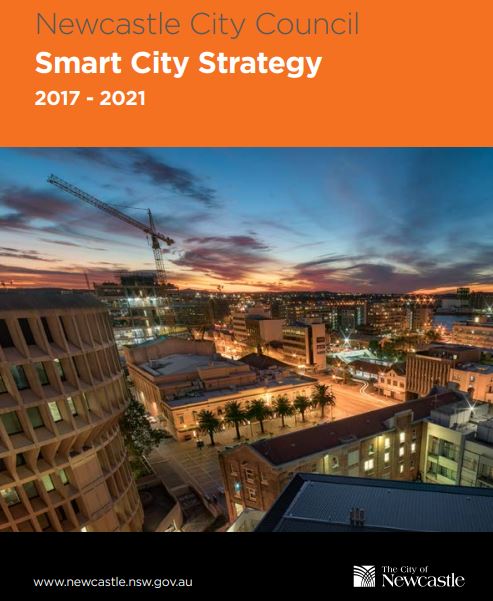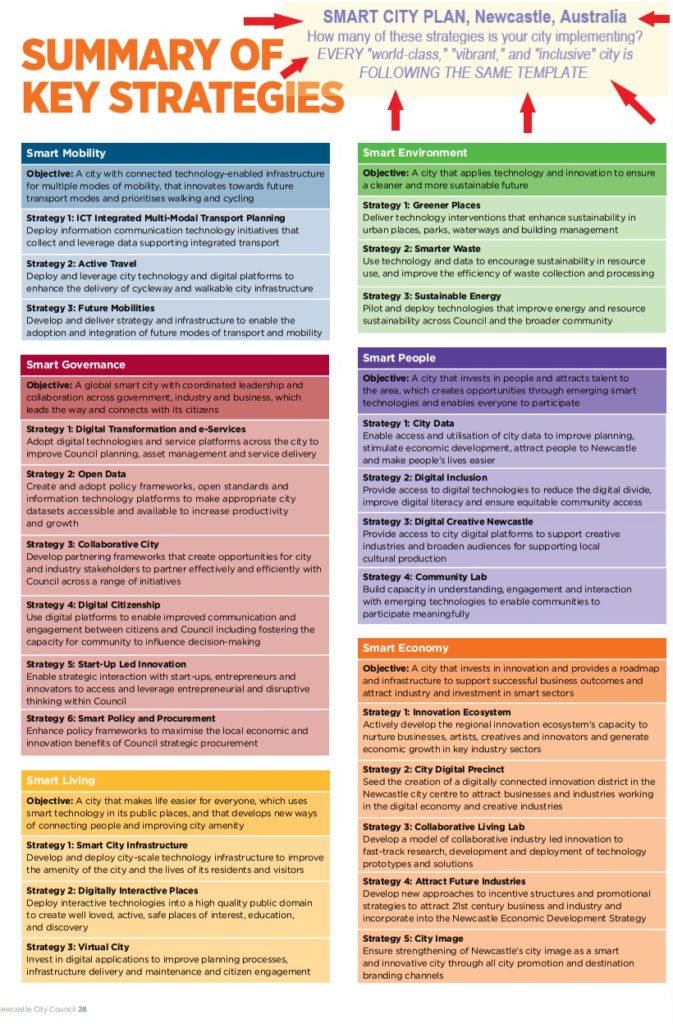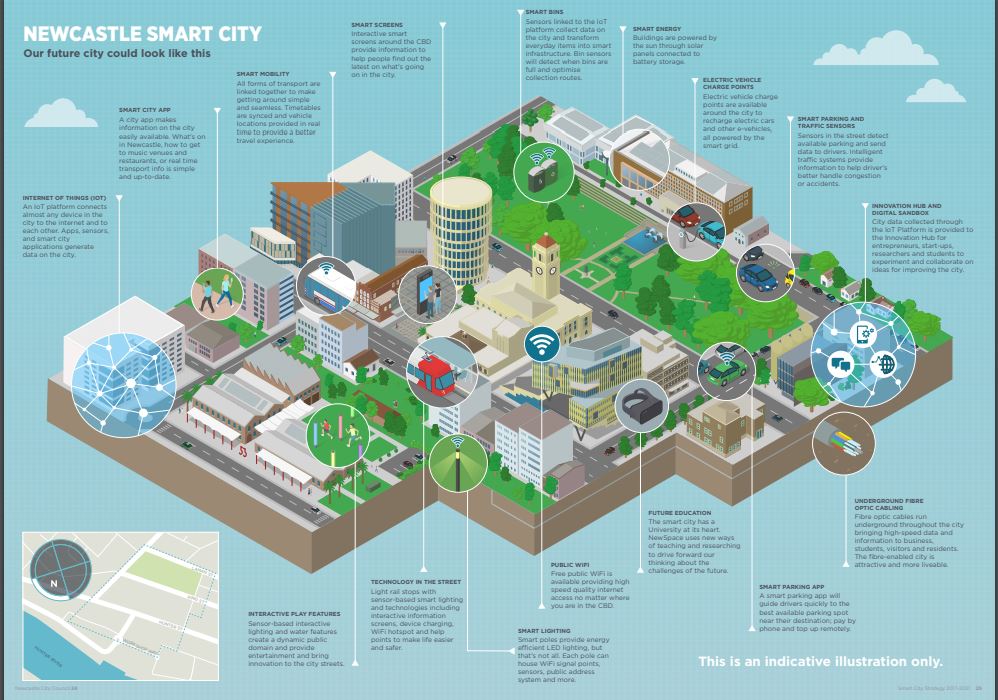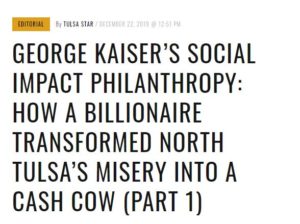SOCIAL IMPACT INVESTING AND PAY FOR SUCCESS
The relationship between big philanthropy and social accountability is a topic that has become increasingly salient as the gap between America’s wealthiest individuals and the bottom 90% continues its rapid expansion. For those in the lower wealth percentiles, the gap has enormous consequences on the ability of individuals to provide for their most basic needs. As a Forbes article put it, “the poorest 50% of Americans are literally getting crushed by the weight of rising inequalities.” Though 2019 confronts us with circumstances that make this question urgent, the question is not new. Even in the early days, the power of big philanthropy gave rise to concerns about the erosion of public oversight. One historical sketch cites a 1912 warning about the power of the Rockefeller Foundation, whose “domination” was “being rapidly extended to control the education and ‘social service’ of the Nation.”
Thomas J. Tierney, an expert on philanthropic strategy and co-founder of the Bridgespan Group, explained that what is relatively new, however, is “social impact” philanthropy, a business-model approach that seeks to increase both “impact and financial returns by continuously striving to achieve better results with the same or fewer resources.” In 2007, he called on the philanthropy sector to appropriate practices widely used in business. This came after The Annenberg Foundation released a report in 2002 that showed only mixed results for its Annenberg Challenge, a landmark campaign to transform public schools across the country. The takeaway from the Challenge and the report was that the problems facing society are so massive that they must be addressed according to the business principle of “disciplined, quantifiable, and financially centered bottom-line thinking—crunching numbers and keeping score.” Data—lots of it—is key: “Mountains of solid data combined with thoughtful, rational decision-making are essential to achieving results. The right numbers, correctly crunched, provide a source of competitive advantage.”
Although results-based philanthropy might be more effective at tackling massive social challenges, it carries its own host of problems. One danger of a quantitative, outcomes-oriented approach to setting and evaluating social impact benchmarks is that the philanthropic organization becomes a business de facto, albeit one with tax-exempt status. Moreover, in an increasingly complex and connected world, the input-output effectiveness assessments of specific social interventions become valuable in their own right. Funded by the deep pockets of big philanthropy and capable of touching almost every aspect of clients’ lives, these assessments can achieve remarkable levels of precision and comprehensiveness in collecting the data used to develop the next round of “changemaking” strategies. When the assessment data becomes more valuable than the mission-specific outcome of the intervention, what is to prevent a service organization from dropping the philanthropy mantle altogether and wholly embracing the business model?
This brings us to the business of “impact investing,” which, in a 2016 article, businessman and social entreprenuer Jim Sorenson describes as “leveraging private capital for social good” through decisions made on the basis of the growing body of research on the connections between social spending and specific outcomes. Sorenson, who made his fortune in media technology and biomedical data management systems, and serves as an advisory board member at the technology investment fund, Epic Ventures, observed that impact investors look to fund initiatives that are aligned with their values and are well-managed, but that explains only part of their motivation. In addition, he writes, “impact investors are motivated by double or even triple bottom-line opportunities to earn a financial return while also doing something good for society. Securing a financial return helps ensure that the organization generates measurable impact that is scalable and self-sustaining over time.”
How is it that social impact investments generate a financial return for socially-conscious investors? In order to answer that question, one must look to the work of University of Chicago economist James Heckman, whose “Heckman Equation” is notable for demonstrating how investments in early childhood education programs may generate up to a 13% ROI, as a Center for High Impact Philanthropy whitepaper explains, or even up to 15%, as reported by Forbes. Alison McDowell, a respected blogger and public lecturer on the subject of impact investing, has extensively researched and written about this process in her blog, WrenchInTheGears.com. She explains that Professor Heckman’s insight into the financial benefits of targeted social interventions, pitched in combination with a business strategy for scaling developed by the tech-oriented venture capitalist and Illinois politician J. B. Pritzker, can persuade policy makers to replace traditional public services with private high-impact programs. In other words, strategic investments in social programs that have a proven record of meeting certain benchmarks yield substantial economic benefits for those served by the programs, for governments, for investors, and for society at large. This proven record of economic gains can serve as a selling point to government service providers who might be persuaded to outsource public services if a private service provider (backed by high-impact investors) can virtually guarantee a certain set of desirable outcomes.
Goal-oriented philanthropic investors have seized upon the social impact investing model by forming large consortiums of like-minded, super-wealthy social “change-makers” in order to combine their investment resources and drive large-scale, innovative responses to pressing social concerns. One example of such a consortium is Blue Meridian Partners, a conglomerate of super-wealthy impact investors, including former New York mayor and founder of Bloomberg Philanthropies, Michael Bloomberg Michael Bloomberg. Blue Meridian’s website states, “We make big bets, up to $200 million, on each of our investees. Scaling plans are at the heart of Blue Meridian’s large-scale investments.” To that end, Blue Meridian’s investees receive flexible, upfront growth capital and annual payments for successful completion of performance milestones.
Blue Meridian only invests in programs that can demonstrate successful outcomes. Any program receiving Blue Meridian funding must carefully monitor its work and share the results with a Managing Director assigned to their sponsored programs. This investment gives Blue Meridian access to the stores of data about the populations who receive assistance from these sponsored programs as well as data linked to the success rates of specific interventions. This data may become a valuable source of information for developing commercial strategies in unrelated business ventures. In other words, impact investors, like Blue Meridian, receive a very valuable benefit from high-impact philanthropy: a virtual goldmine of “human data capital”—information about how people make choices, what external factors may be applied to individuals for the purposes of altering behaviors, how certain populations might differ from others in key respects — all of which provides high-impact philanthropists with the tools they need to effect the social change that they wish to see.
SOCIAL INNOVATION FINANCE AND SURVEILLANCE CAPITALISM
In the past decade, economists and businessmen have figured out a way to monetize the success potential of social impact programs by analyzing the human behavioral data collected by social impact philanthropy and using it to speculate on social-innovation-finance-agreements futures. The Social Innovation Finance (SIF) model is a new funding mechanism designed to facilitate the large-scale implementation of successful results-oriented social interventions in a way that poses little financial risk to taxpayers. SIF combines two instruments: 1) a performance, or “Pay for Success” (PFS), contract that stipulates the specific results that constitute program “success,” and 2) a privately-issued “Social Impact Bond” (SIB), or operating loan, to cover the upfront costs of delivering the service intervention. According to The National Conference of State Legislatures:
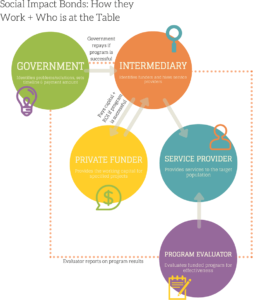
Source: National Conference on State Legislatures
Social Impact Bonds (SIBs), a type of pay-for-success funding agreement, work by allowing private entities to provide upfront capital that government can repay later. This makes SIBs essentially a contract between a private entity and the public sector. The private party commits to pay for a program that leads to improved social results and public sector savings. The private investors are then repaid when contractually agreed upon objectives are achieved.
The SIF funding mechanism is often referred to simply as PFS financing or SIB financing and its popularity is growing. A 2019 report by Nonprofit Finance Fund, a leader in PFS program development and financing, states that, in 2018, 25 PFS were programs implemented across the country in multiple policy areas and supported by both state and federal legislation. Consistently, advocates highlight the potential of PFS projects to bring about necessary social innovations based on evidence-based practices that are effective and free of partisan or personal bias.
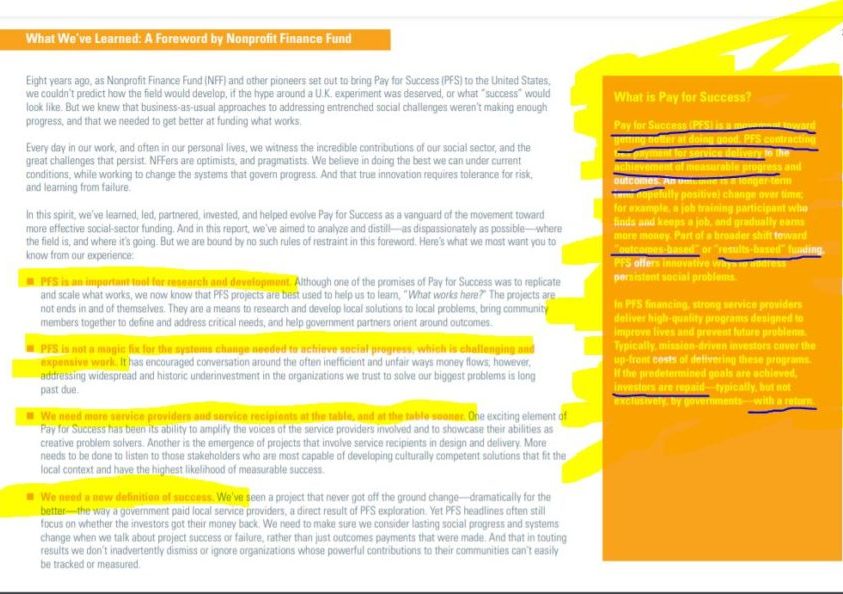
Because SIF pays for results achieved “outcomes” rather than “outputs,” the private funders who cover the up-front costs of service delivery have a financial incentive to ensure that social service providers know and employ the most effective methods for meeting performance expectations. One way to do this is to collect as much human behavioral data as possible in order to develop very accurate predictive algorithms. The SIF system encourages social impact investors to extract as much human data as possible–data about experiences, thoughts, choices, feelings, preferences, and any other factors that help investors predict and modify human behavior. This data may be collected from things like surveys, reports, camera and audio surveillance, access badges, web-based learning or record-keeping applications (such as educational technology and training programs), even video games. It is analyzed not simply to understand how or why people make the choices that they do, but also to determine how some choices may be encouraged and others discouraged. It has the potential to create a lucrative cycle of impact protocols that not only promote the mission-oriented outcomes that social impact investors support, but also generate an ROI for the social impact investors.
In her recent book, The Age of Surveillance Capitalism, Harvard professor Emerita Shoshana Zuboff explains how companies like Google and Facebook harvest data from users, often without their consent, in order to develop products that are able to predict and control behavior. In an interview with The Harvard Gazette, Zuboff stated:
The competitive dynamics of surveillance capitalism have created some really powerful economic imperatives that are driving these firms to produce better and better behavioral-prediction products. Ultimately, they’ve discovered that this requires not only amassing huge volumes of data, but actually intervening in our behavior. The shift is from monitoring to what the data scientists call “actuating.” Surveillance capitalists now develop “economies of action,” as they learn to tune, herd, and condition our behavior with subtle and subliminal cues, rewards, and punishments that shunt us toward their most profitable outcomes.
The competitive dynamics of surveillance capitalism have created some really powerful economic imperatives that are driving these firms to produce better and better behavioral-prediction products. Ultimately, they’ve discovered that this requires not only amassing huge volumes of data, but actually intervening in our behavior. The shift is from monitoring to what the data scientists call “actuating.” Surveillance capitalists now develop “economies of action,” as they learn to tune, herd, and condition our behavior with subtle and subliminal cues, rewards, and punishments that shunt us toward their most profitable outcomes.
Although she is referring to for-profit commercial activities, the dynamics of surveillance capitalism apply to social impact philanthropy as well. Quoting from Zuboff’s book, an article in The Guardian explains that “prediction products are traded in a new kind of marketplace that I call behavioural futures markets. Surveillance capitalists have grown immensely wealthy from these trading operations, for many companies are willing to lay bets on our future behaviour.” Social impact bonds, or pay-for-success contracts, become the stuff of behavioral futures markets for which investors and financial speculators may take a “short” or “long” position in the same way they would with any other type of financial instrument. Only in this case, the course of an individual’s life is the object of speculation. In this way, social impact philanthropy makes a commodity of the vulnerable people whom it claims to serve through their social programs. Program assessment data–the data harvested from the recipients of philanthropic social interventions and which is used to quantify impact–contributes to the development of more sophisticated and effective social interventions. It gives financial speculators a strategic advantage in selecting behavioral-futures investments positions (and these might be on the side of success or on the side of the failure of some interventions) that are most likely to generate maximum profits.
What does this complicated system of high-impact social changemaking have to do with Tulsa? A lot, actually. Tulsa relies on Mr. Kaiser’s philanthropy for the provision of many basic social services, such as education, housing, and healthcare. Mr. Kaiser is one of the principal members of Blue Meridian Partners, which has a special regional initiative in Tulsa. Mr. Kaiser also serves on the Leadership Advisory Council of Too Small to Fail with J.B. Pritzker, whose work with Professor Heckman has contributed to the Social Impact Bond market and, as a result, to the hyper-growth of surveillance capitalism. Mr. Kaiser’s ties to the Silicon Valley Tech industry, the world of big philanthropy, and the human data capital markets touch the interests of all Tulsa residents. One source reports that Mr. Kaiser has been called “the godfather of Tulsa philanthropy.” His influence is wide and deep and continues to expand. GKFF, in fact, was the major supporter of Oklahoma’s first PFS program, the Women In Recovery prison diversion program, which went into effect in 2017. Moreover, the State of Oklahoma recently enacted the “Pay for Success Act” on November 1st of this year (Oklahoma Statutes, Section 9010.2 of Title 62), which encourages greater reliance on public-private-partnerships and PFS programs to tackle social policy issues. The ways in which this situation affects the lives of North Tulsans who depend on the public services administered by Mr. Kaiser’s social impact programs–and how this, in turn, affects the flourishing and political power of the larger North Tulsa community–will be the subject of my next piece in this series.

